Scientists in Denmark say they’ve discovered two extraordinary sets of human footprints dating back 5,000 years.
The first of their kind to be found in Denmark, the footprints may shed light on what life was like for coastal people during the Stone Age.
Terje Stafseth, an archeologist with the Museum Lolland-Falster, was among those who helped excavate the ancient prints and called them an extraordinary find.
“Normally, what we find is their rubbish in the form of tools and pottery, but here, we suddenly have a completely different type of trace from the past, footprints left by a human being,” Stafseth said.
The footprints suggested that back in the olden days, at least two people would step out onto the swampy seabed to inspect their fishing gear, which not only led to the formation of prints on the seafloor, but also showed evidence that a fishing system was present during the Stone Age, according to Discovery News.
The prints were found while doing work for the Fehmarn Belt link scheme, an immersed tunnel set to connect the German island of Fehmarn and the Danish island of Lolland, and were found beside a set of fixed gillnets on stakes.
“We have direct imprints from ancient people’s activities, which can be associated with a concrete event – a storm destroying the fixed gillnet on stakes. In order to secure the survival of the population, the fishing system had to be repaired,” Anne-Lotte Sjørup Mathiesen of the Museum Lolland-Falster said to Discovery News
“Their footprints were covered with a layer of sand and dirt shortly after, and have been there since,” Sjørup Mathiesen said. “One print is very small compared to the other. At the moment we can’t tell whether it belonged to a boy or a woman.”
She added that so far, all they knew of the prints was that they corresponded to foot sizes 36 and 42, or sizes 5.5 for women and size 9 for men in the U.S. respectively.
Lars Ewald Jensen, project manager for the Museum Lolland-Falster, provided pictures of their excavation at Denmark to Live Science.
Jensen said that aside from the prints and gear, they also found the location of an ancient burial and sacrificial site where wild and domestic animals were killed and offered to the sea. He said that he and team were working to uncover more of the footprints and tools and check the area as quickly as they could before they resume the operation of the Fehmarn Link project.
Agencies/Canadajournal
 Canada Journal – News of the World Articles and videos to bring you the biggest Canadian news stories from across the country every day
Canada Journal – News of the World Articles and videos to bring you the biggest Canadian news stories from across the country every day



